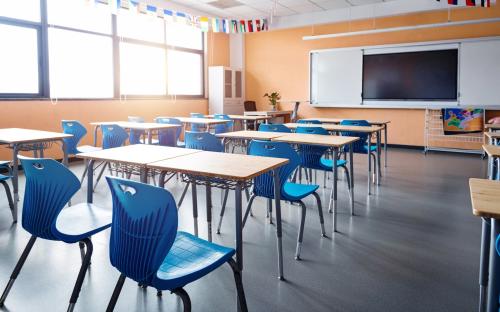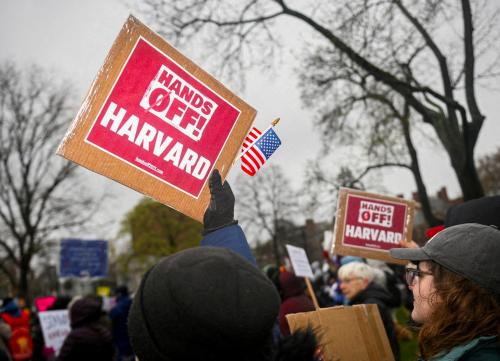As we head into 2025, experts from the Brown Center on Education Policy are following an assortment of education-related stories. Here’s what’s on their minds as they look ahead.
A new administration and the Supreme Court decision that could complicate matters
With the transition of power from the Biden administration to the Trump administration, there are a lot of obvious things to look ahead to. Higher education, immigrant students (all ages), and the definition and enforcement of civil rights will be in for some big changes. (No, the U.S. Department of Education isn’t going anywhere, and K-12 funding will likely be minimally affected.)
The Supreme Court’s Chevron reversal is an interesting wildcard. On the one hand, this is supposed to help the administration “drain the swamp” by limiting the influence of public agencies. But what the reversal really does is build levees around the so-called swamp. Once in office, guess which side of the levee the administration is actually on? Much of what the administration wants to do involves ignoring the Chevron levee. Look for education groups to sue the administration using this new legal precedent.
A large federal tax credit to support private and home schooling seems much more likely this time around. I’ll also be looking at the evolution of the growing number and breadth of state voucher programs. As I’ve said, this movement toward super-vouchers, which can be used for both private school tuition and other education expenses, is the biggest shift in K-12 education policy since Brown v. Board of Education.
A tax bill with implications for students and schools
My eyes will be on tax reform. A tax bill likely will be among the first and most consequential items on the Trump administration’s agenda. Early in his first term, Trump signed the Tax Cuts and Jobs Act into law, and key provisions of that legislation expire in 2025. Many elements of the upcoming tax reforms will affect students and families. I’m paying particular attention to two of them: the child tax credit (CTC) and a possible tax-credit scholarship program.
After the Biden administration expanded the CTC in 2021, the child poverty rate plummeted. It bounced right back when Congress allowed the expansion to expire. Now, both Republicans and Democrats want an expanded CTC, though they disagree about issues like work requirements and phaseout rates. Those details matter—and will have implications for students given the links between poverty, learning, and wellbeing.
What could happen with a tax-credit scholarship program is even hazier. Many GOP-led states have built large-scale, private school choice programs in recent years. Some Republicans would like to see a federal program. However, voucher-type programs have proven unpopular with voters and many elected Republicans. The clearest path, politically, might involve hiding a school choice program within a broader tax bill. Hopefully, voters will be paying attention.
How state and federal policymakers address college costs
In 2025, I’ll be watching how state and federal legislatures address college costs. The bulk of the Biden administration’s higher education policy around affordability focused on student loan forgiveness. While many of those targeted policies had significant impacts, the administration’s income-driven repayment and widespread student loan forgiveness proposals will almost certainly be struck down through the courts or the next administration.
What comes next? The College Cost Reduction Act (HR 6951) proposed by Representative Virginia Foxx (R-N.C.), outlines a potential unified Republican government approach to higher education policy. CCRA proposes to reduce the amount of loans disbursed to students (including eliminating graduate PLUS loans), change loan repayment options, and enact a new “risk sharing” policy billing colleges for graduates’ unpaid loans. Though unlikely to advance in the current Congress, it lays a blueprint for potential policies in the coming year.
At the state level, several legislatures have advanced “free college” policies to provide additional financial aid (see new programs passed in Michigan, Massachusetts, and Colorado). However, other states such as Minnesota and Indiana have recently needed to reduce state scholarships in the face of budget shortfalls. States want to support affordable “degrees of value,” but face binding budget constraints.
It’s clear that the cost of college remains a challenge to students. Striking the balance between loans and the relative support from state versus federal grants is a challenging policy problem, but one that deserves continued focus to ensure income constrained students can access the postsecondary programs that best equip them for long-term success.
The administrative presidency of Donald Trump
The administrative presidency of Donald Trump’s second term will loom large in education in 2025. During Trump’s first term, the White House’s hostile takeover of the federal government did not lead to a major overhaul of the U.S. Department of Education (ED), even though civil rights enforcement was substantially weakened and there was strong federal deference to state rights. Trump’s second term is likely to incur broad policy effects, especially with his tight grip over the Republican majority in both the House and the Senate. A shrinking pool of moderate Republicans will not be able to offer sufficient checks and balances.
Trump’s unilateral actions could bring both sweeping and targeted changes. Sweeping actions could include Trump’s push for congressional approval to dismantle ED, federal enforcement of deportation of youths and families who lack a legal status, conversion of Title I into demonstration vouchers for private and religious schools, significant program cuts and ED layoffs, and advocating for higher taxes on university endowment. Targeted policy actions may reduce and/or consolidate funding in Title I and other categorical programs, and increase deference to states on accountability, civil rights, DEI issues, and school choice. Clearly, 2025 will be a pivotal year for the administrative presidency to redefine the federal role in education.
The potential weaponization of the Office for Civil Rights
I’ll be monitoring the Trump administration’s plans for federal civil rights enforcement in K-12 schools and colleges and universities. Trump has promised to reverse Biden-era Title IX protections for LGBTQ+ students, which prohibit discrimination based on gender identity and sexual orientation. These legal protections impact schools’ policies on pronoun use and students’ access to bathrooms and locker rooms, on top of defining harassment and bullying of LGBTQ+ youth based on their gender or sexual identity as a federal civil rights violation.
Trump has also pledged to bar transgender student athletes from playing sports and to cut off federal funding for schools that teach what Trump calls “woke ideology,” “gender insanity,” and “critical race theory.” The incoming administration may try to restrict trans student athletes through more expansive revisions to the Title IX regulations. The path to punishing schools for teaching “woke ideology” is less straightforward. That’s because federal law expressly prohibits the education secretary from tying federal funding to school curriculum decisions. Still, according to recent reporting and Project 2025’s education chapter, the incoming administration may try to get around this by weaponizing civil rights enforcement. This could entail redefining discrimination under Title VI (racial/ethnic) and Title IX (sex-based) and terminating federal funding as a penalty for violating civil rights law.
How successful they’ll be in achieving their aims will depend on several factors. These include key political appointments in the Office for Civil Rights, the specific language of new regulations, and how, when, and where legal challenges are brought in federal court.
The Brookings Institution is committed to quality, independence, and impact.
We are supported by a diverse array of funders. In line with our values and policies, each Brookings publication represents the sole views of its author(s).

















Commentary
Brown Center scholars look ahead to education in 2025
December 16, 2024